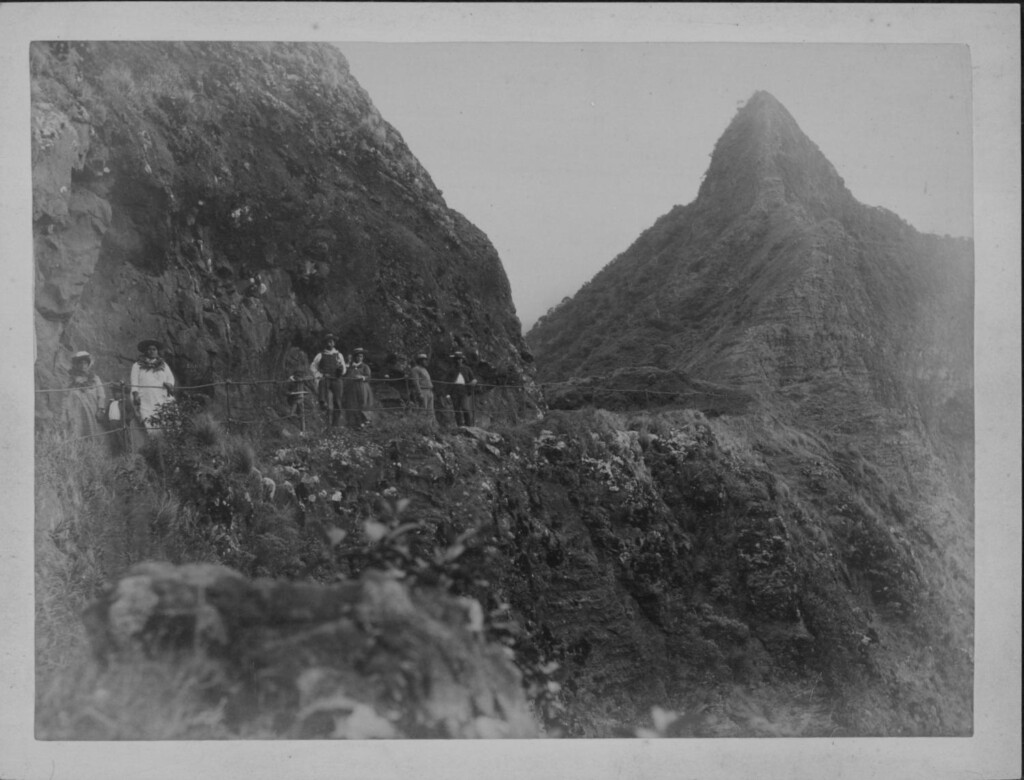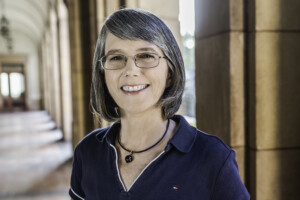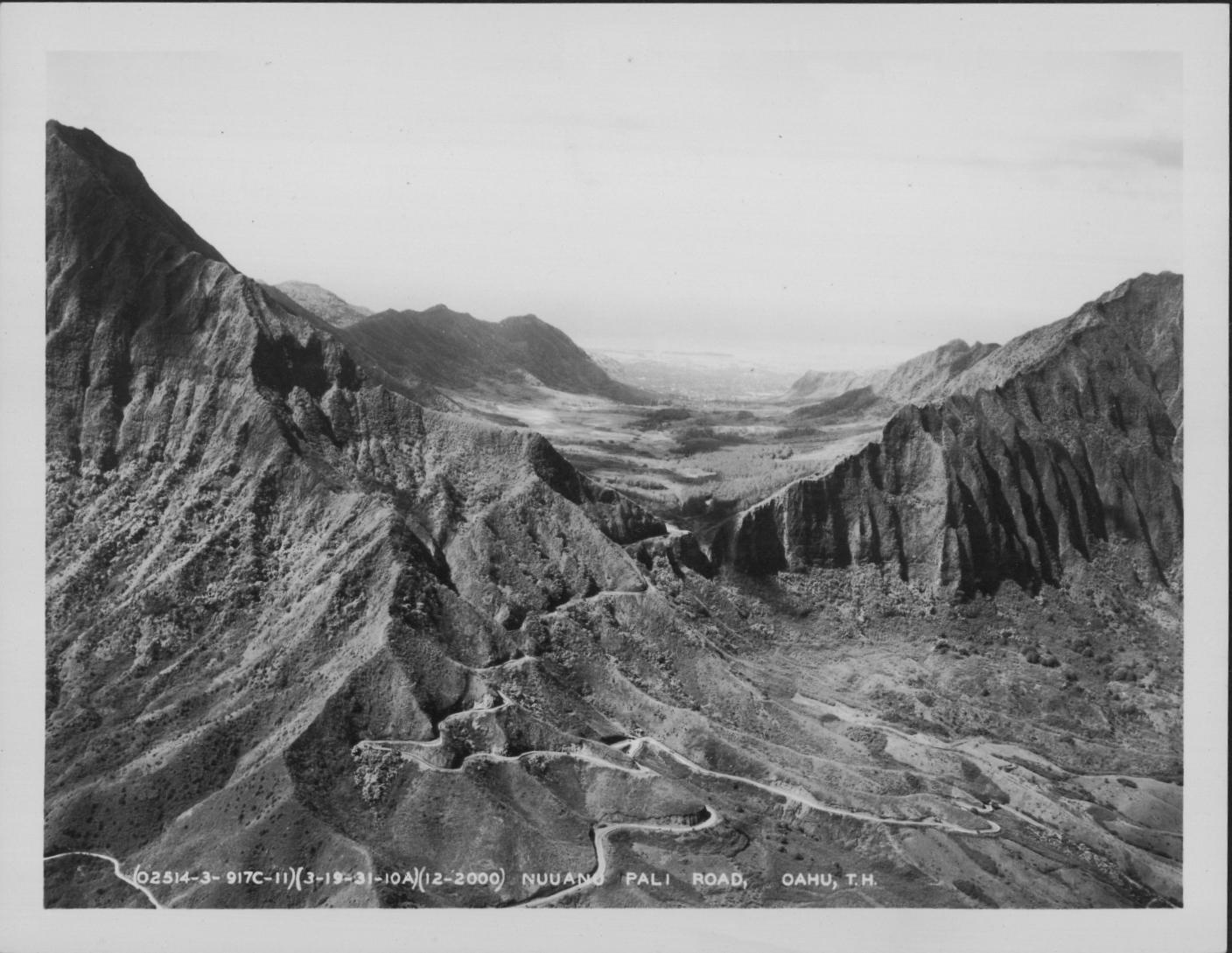Footpath to First Road before the 20th Century
by Ann Yoklavich
From at least as far back as the late 1700s, in some of the first written histories in Hawai‘i there have been accounts of the footpath that traversed the precipice of the windward side’s Pali up to the narrow pass at the eastern end of Nu‘uanu Valley. There is no known date of the first trail building here, but it pre-dated western contact, since this vicinity for the cross-Ko‘olau trail provided “the most direct route between Windward Oahu and Honolulu.”[1] Foot traffic increased between the windward and leeward sides of this range, as the needs to communicate and trade grew after Western contact, since most foreign trading ships gathered in Honolulu Harbor.

The Pali trail, date unknown. Source: Hawai‘i State Archives: PP-60-2-29.
Foreigners found the trail fearfully steep at the top of the windward side, with a sheer drop of several hundred feet. Many first-time visitors to the Pali view point, at the top of the trail, noted that Hawaiians negotiated the path with assurance and ease.

The Pali horse trail, date unknown. Source: Hawai‘i State Archives: PP-60-2-19.
Demands for improvements to the footpath “began by the 1830s and were primarily driven by foreigners.”[2] Many wanted to plant on the fertile and well-watered windward lands, but needed better access across the Ko‘olau range for exporting, or for selling in Honolulu’s larger market, their agricultural products, including sugarcane. In 1845, during the reign of King Kamehameha III, improvements to the footpath transformed it into a horse trail. The king and his minister of the Interior, Gerrit Judd, were the first to ride the trail on horseback.[3] A rainstorm in 1848 washed out an embankment and repair work was slow, fueling frustrations of windward residents, who wanted a widened way for wagons. For most of the remainder of the 1800s, the horse trail remained primitive and too dangerous for buggies and wagons. Although in 1861 a wagon was driven down the horse trail and the following year a buggy made it up the Pali, “by 1869 drivers were warned not to attempt [such] daring stunts.[4] An 1898 article noted: “Accidents were not rare,” for horses and riders, or even for sure-footed mules.[5]
The precipitous topography and the high cost of altering the sheer cliff of the Pali prevented the Kingdom from attempting to build a carriage road. Acrimonious newspaper articles, especially in the Pacific Commercial Advertiser (PCA), about government inaction on the road during the late 1800s reflected political tensions between the monarchy supporters and those desiring annexation to the United States.
It was not until after the overthrow of the monarchy, under the Republic of Hawai‘i government, that engineering plans, appropriations, and a contractor bid below the funding limit all combined to allow construction of the first road over the Nu‘uanu Pali. In May 1897 John Wilson and Louis Whitehouse were awarded the contract for $375,000 to build the new carriageway, since theirs was the only proposal under the $400,000 appropriation. Wilson was Honolulu-born and had Hawaiian, Tahitian, and European ancestors, while Whitehouse was from Oakland, California and of European descent. They had met in the engineering department of Stanford University and were young men starting their firm together.[6]
The 1898 article describes in great detail how the new roadway of 7,620 feet was constructed, with the aid of blasting powder and dynamite. The subgrade width was 20 feet, with a 16-foot wide macadamized roadway that was 1½-feet deep. On the Honolulu side, 600 feet followed the course of the old road as did 400 feet on the windward side, but this section was 20 feet above the old horse trail, with the new road on an embankment “held in place by a masonry retaining wall.”[7] Wooden railings were installed on the outer edge for 8,000 feet from the top of the Pali, with a stone gutter the entire length, and ditches every 150 feet to provide proper road drainage.[8]
By the date the Nu‘uanu Pali Road was built, its role in stimulating tourism, for the ‘must-see’ vistas it provided, was more important to the economy of Hawai‘i than as a route for transportation of agricultural products. Windward lands were found not suitable for sugar plantations well before the end of the 1800s.
News articles, during and just after 1897, about the Nu‘uanu Pali Road praised Wilson and Whitehead, noting they had “made a better road than the specifications” required.[9] A 1920 Pacific Commercial Advertiser article observed that the road by then “bore no resemblance to the 1898 carriageway,”[10] due to widening and paving projects after 1900; but it still praised (perhaps over-praised) Wilson’s importance and role in the project. This was helpful to Wilson’s career, since soon after he was subsequently appointed Honolulu’s mayor following the death of Joseph Fern. He served as mayor for 19 years between 1920 and 1956. He was in the Democratic party since its founding in 1900 and was one of “the most influential politicians in twentieth-century Hawaii.”[11] He lived to see Democrats become the Territory’s dominant political party after World War II.
Special Mahalo to Dawn E. Duensing, an old friend and passionate historian.
Image at top: Pali Road circa March 21, 1924. Source: Hawai‘i State Archives.
[1] Most information in this history was drawn from Chapter 4 in Dawn E. Duensing 2015, Hawaiՙi’s Scenic Roads: Paving the Way for Tourism in the Islands (Honolulu: University of Hawaiՙi Press). This quote from p. 100.
[2] Ibid.
[3] Ibid., p. 107.
[4] Idid., p. 111.
[5] Daniel Logan, 1898, “The New Pali Road,” The Hawaiian Annual 1898 (Honolulu: Thos. G. Thrum, Publisher), p. 141.
[6] This paragraph synthesized information from the above two sources.
[7] Logan, p. 143-144.
[8] Ibid., p. 144.
[9] Duensing, p. 124.
[10] Ibid., p. 126.
[11] Ibid., p. 129.

Ann Yoklavich is an Architectural Historian, semi-retired from MASON where she was employed for a third of a century, earning a reputation for diligent research and engaging writing. Ann remains a consultant to MASON on select projects. She enjoys sharing her love of Hawai‘i’s history, especially on architectural tours for the American Institute of Architects, Honolulu Chapter.
The 125th anniversary of Nu‘uanu Pali Road will be celebrated at the 2022 Preservation Honor Awards Ceremony and Reception on October 20, 2022. Click here for information about the event.
Further resources:
- Additional historical photos of Nu‘uanu Pali Road may be viewed in the Hawai‘i State Archives online collection: Browse Catalog – Digital Archives of Hawaiʻi (hawaii.gov)
- “The Pali”, Images of Old Hawaii by Peter T. Young. https://imagesofoldhawaii.com/the-pali/


